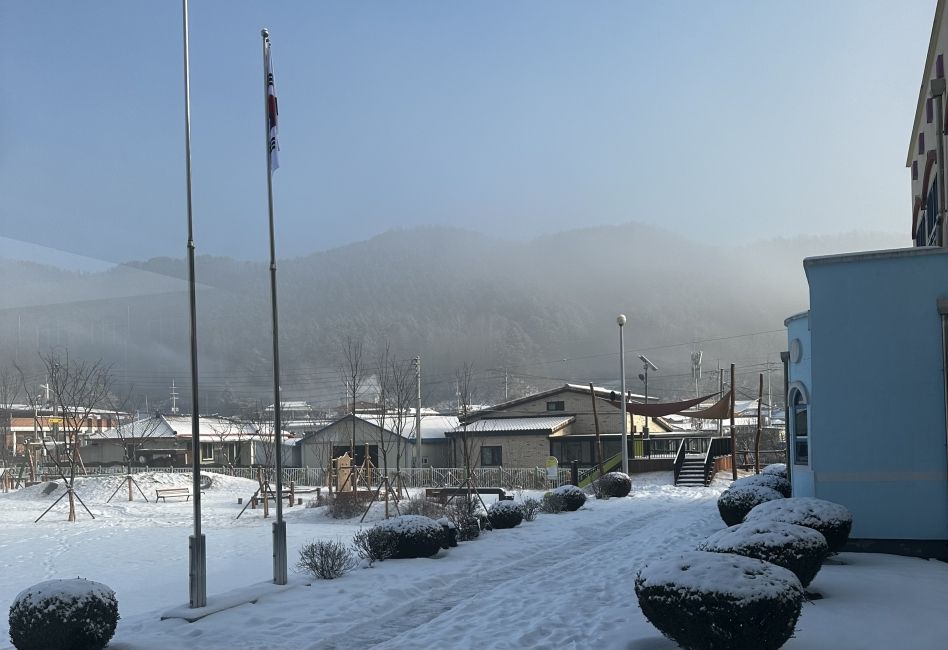What’s It Like Teaching English at a Public School in South Korea?
Children run by yelling “Hello teacher!” one after another as I put on my work slippers. There are many differences between schools in the US compared to South Korea. I will highlight four components of life as the only native English teacher at this elementary and middle school in rural South Korea: the commute, work environment, responsibilities, and school lunches!
Commute
Every morning I leave my apartment by 8:10 am and walk for about 30 seconds to wait for the school bus. Fortunately, my school allows me to take the school bus to work, making my morning commute simple and efficient.
On the other hand, the evening commute can be a bit more time consuming. The students leave for home at 4:00 pm at the end of the day, but teachers in Korea must stay at work until 4:40 pm so I cannot ride the school bus back. There is a bus stop about five minutes from the school, so I wait for the next bus which comes at 5:15 pm every day. After riding the bus for 15 minutes it takes me 30 minutes to walk home from the bus stop. Luckily, the teachers at my school are quite friendly so most of the time they offer to take me home!
Responsibilities
As a native English teacher in South Korea, the majority of my day is spent either teaching classes or lesson prepping. While other Korean teachers have administrative duties in addition to classes, Native English teachers are not tasked with responsibilities outside of teaching.

Elementary School Classes
Every week I teach eight elementary classes. Elementary school classes are 40 minutes long and typically follow the same format: vocabulary review, key expressions, the textbook lesson, and then a game. While this does not leave much room for exciting lessons, the game is a great opportunity to cater to the interests and learning styles of the students. For instance, my 6th-grade students were tired of the English games they had played for years with their previous English teachers. So after much trial and error, I discovered their excitement playing Hot Seat. It was a great way for them to recall vocabulary and speak English with less structure.
Because I teach in a small rural school, the elementary school day officially ends at 1:40 pm. From 1:50-4 pm, the students have after-school classes, which include P.E., art, dance, English, and more. So each week I teach an additional eight after-school English classes. These classes are completely open-ended, with no curriculum, textbook, or input from other teachers. The students expect games and are not typically open to much serious learning–especially the older students. It’s best to use this time to get to know the students better and to teach using non-traditional methods. For instance, my students loved playing a custom apples-to-apples game featuring Korean actors, singers, foods, places, etc.
Middle School Classes
Once a week I teach at a middle school. While I see my elementary school students nearly every day, I only see the middle schoolers once a week. Therefore, rather than worrying about the curriculum during class time, I prioritize speaking. The middle school has a non-native English teacher who teaches the majority of the textbook–vocabulary, grammar, reading, and writing. My responsibility at the middle school is to cover the speaking sections of the textbook. This takes about ten of the 45-minute middle school class period, so I spend the rest of the time encouraging–at times forcing–the students to speak. Korean students often excel at reading and listening but struggle to produce English. For each of my classes, I spend the first ten minutes picking a handful of students at random, asking them questions like “How was your weekend?” And spend the remainder of the time after the textbook lesson playing a speaking game. As a native English teacher, pronunciation and common phrases are aspects of speaking that only I can teach them. Additionally, I try to show them that learning English can help them communicate with people all over the world!
Lesson Preparation

The most time-consuming aspect of my job is lesson preparation. Teachers at bigger schools may not spend as much time preparing for classes. However, given that I teach 19 unique classes a week with no repeating lessons, the majority of my time outside of class is dedicated to lesson prepping. This was quite stressful when I first started. I would put in a lot of time into lessons, but the students seemed uninterested and I’d often run out of time. But after my first month, I picked up on the students’ interests, how they best learn, and how to be efficient with my lesson prepping. Korshare is an extremely useful and completely free forum where other native English teachers in Korea post their lessons. This helps get ideas for games or activities for both regular and after-school classes.
Work Environment
My school’s work environment is warm, supportive, and independent. Upon arrival, the students and staff were all welcoming, friendly, and eager for me to join their school community!

Students
My students, at both the elementary and middle school, are very sweet. The academic rigor of Korean education doesn’t seem as present in the countryside. The students enjoy plenty of time outdoors, playing sports, reading, drawing, etc. Therefore, there are many opportunities to bond with the students outside of class, implementing bits of English learning without them realizing it. For instance, my second-grade elementary students love to catch insects and show them to the teachers. Whenever they do, I tell them how to say it in English and they repeat it back with excitement!
Compared to the US, students here listen to authority and rarely act out. Therefore, classroom management was not as difficult as expected, especially with my Korean Co-teacher present in the room. And if all else fails, students love positive feedback (100% written on their papers) or candy. I find these to be great motivators for younger students to stay on track. In general, students in rural Korea are rarely afforded the opportunity to meet foreigners, so the impact I make on the school goes beyond the English I teach in class!
Teachers
The teachers here have a similar curiosity about foreigners. When I arrived, the teachers would ask me about myself and the cultural differences between Korea and the US. There are many questions Koreans ask that may seem personal to English speakers. For instance, my co-teachers quickly asked about my age and if I was single, and they even asked if I was religious. It didn’t bother me, it was just surprising because these are not things discussed at work in the US, especially after having just met a coworker. In general, the teachers were interested in getting to know me, and would encourage me when I’d try to use Korean with them! My principal and vice principal are both kind as well, this may be the cause of the warm work environment here :).
While the attitudes of teachers are warm and friendly, the work environment here is also independent. I was confused when my co-teachers (five total) did not seem interested in discussing lesson plans with me. They would simply support whatever I had prepared, rarely giving feedback as well. I later learned that Korean teachers have responsibilities beyond classes. Most, if not all, have administrative duties that keep them quite busy. So teachers trust that their co-workers will complete their duties, and they are committed to fulfilling their own. So my advice for prospective English teachers is to prepare thoroughly and try not to inconvenience other teachers.
School Lunches

The highlight of my day, other than my students’ smiles and energy, of course, is always the school lunch. School lunches in Korea are incomparable to those in the US. Back home in New York, my schools would often serve frozen chicken nuggets and french fries with a carton of milk. I would hardly touch the food, leaving me running out of energy by the end of the day. Comparatively, my co-teachers always joke that I’m one of the first to sit down at lunch and one of the last to leave. I eat two or three trays a day, putting me in a food coma until I have coffee with my co-teachers in the teacher’s lounge.
My small school has three lunch ladies (one nutritionist, a head cook, and an assistant) who work tirelessly all morning to prepare a highly nutritious, restaurant-quality lunch for half the price. It’s buffet style, so you get in line and take a metal tray, chopsticks, and a spoon. Next, I fill my tray with kimchi, rice, some types of meat and veggies, a soup, fruit, and a dessert. The various meals they serve offer a great opportunity to try new Korean dishes. In addition, fruit in Korea is quite expensive, so I’m particularly grateful that they serve oranges, grapes, or strawberries every day! The nutritionist at my school is leaving in March, and I’m curious to see how the food changes. In any case, all other Native English teachers I’ve spoken to here have said the same: that the school lunches never disappoint!
Related Posts

CIEE CHINGU – A Partner Program for Teachers in Korea
Chingu ( 친구 ) is the Korean word for friend . CIEE Chingu is a partner program included in CIEE’s Teach in South Korea programs! Our goal is to connect... keep reading

TWICE with CIEE: Kayleigh in Korea (PART 1)
Kayleigh is a CIEE alum who participated in CIEE's Teach in South Korea program AND CIEE’s Teach in Spain Volunteer program! CLICK HERE to read her experience in Spain. WHY... keep reading

Learn Korean with K-Media: Advice from Valerie!
Hello! My name is Valerie, and I will be teaching in South Korea through the EPIK program starting this spring. With my interests being in Korean cultural studies, teaching in... keep reading
